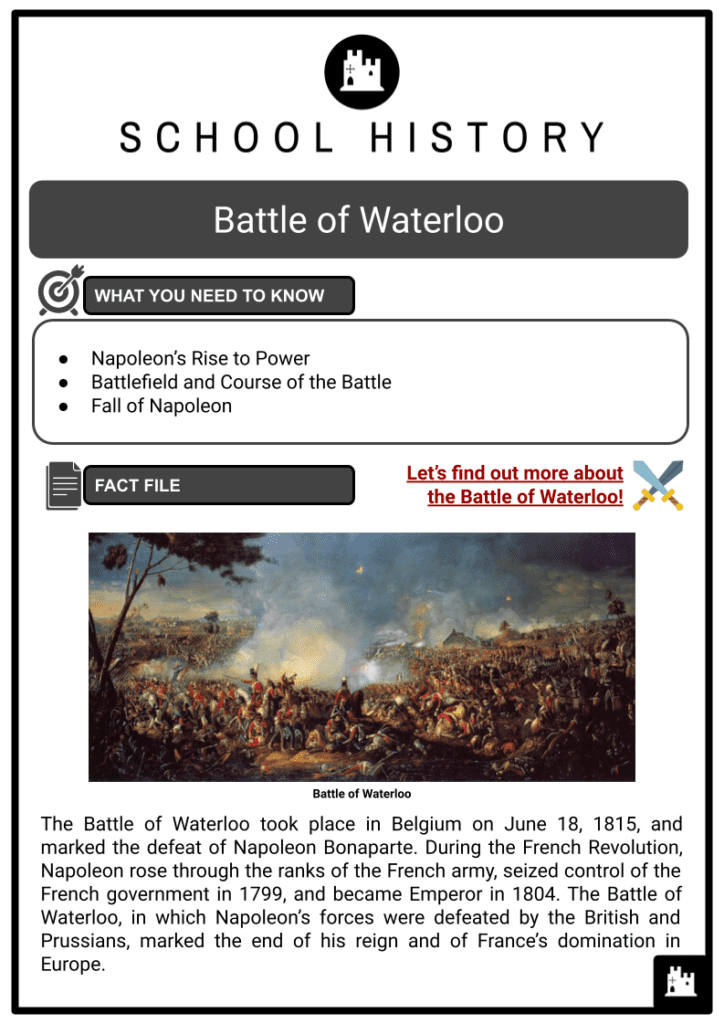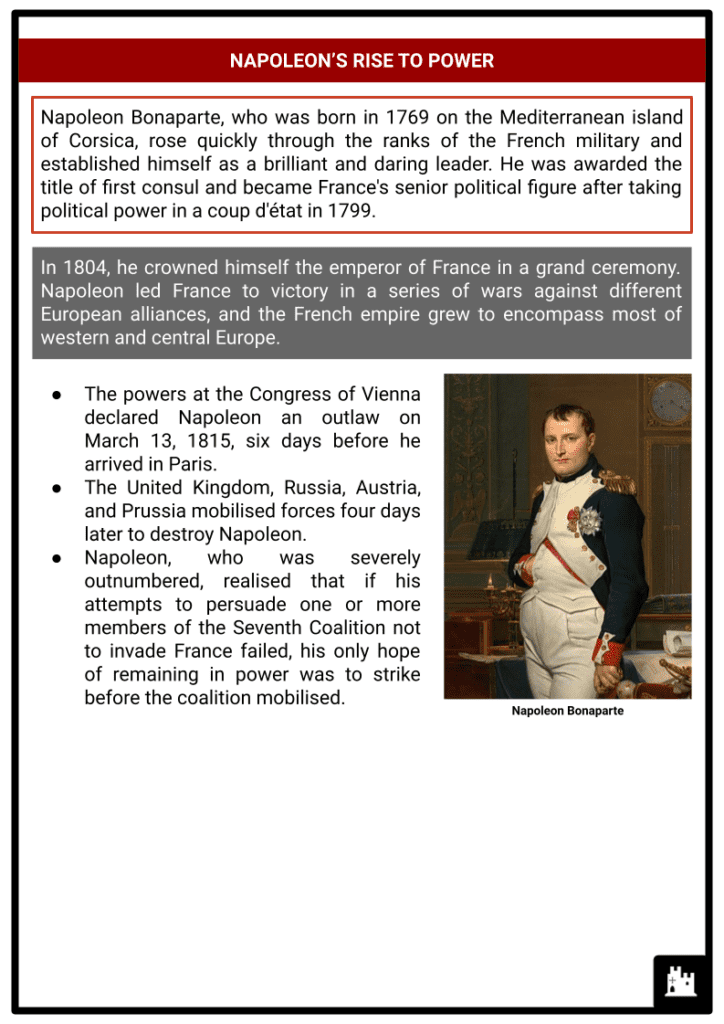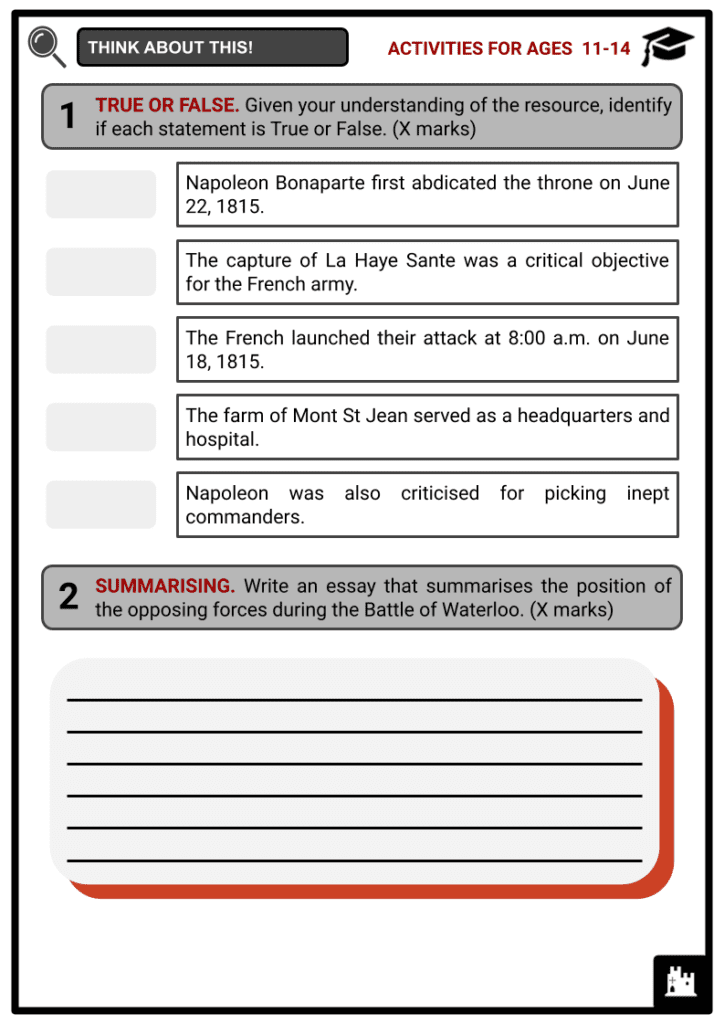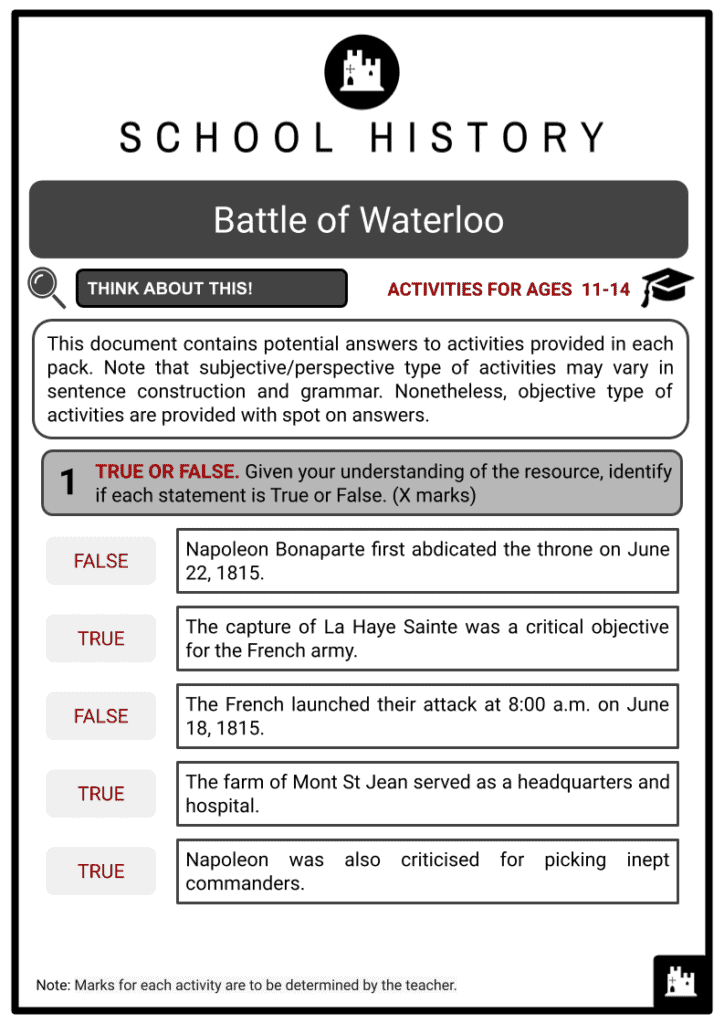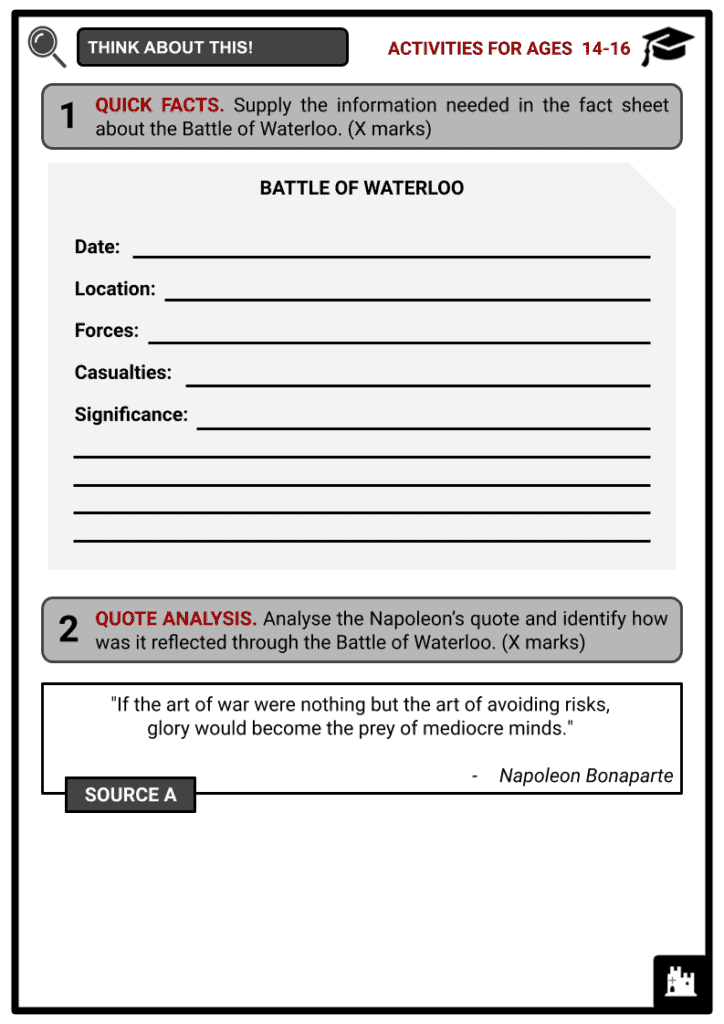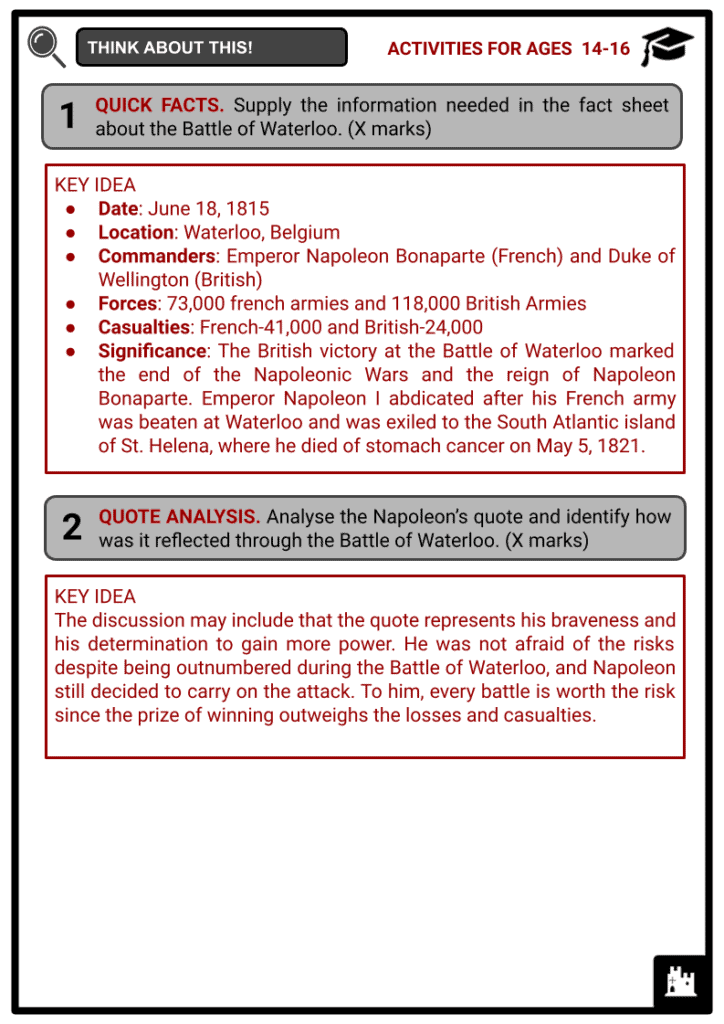Download Battle of Waterloo Worksheets
Do you want to save dozens of hours in time? Get your evenings and weekends back? Be able to teach about the Battle of Waterloo to your students?
Our worksheet bundle includes a fact file and printable worksheets and student activities. Perfect for both the classroom and homeschooling!
Summary
- Napoleon’s Rise to Power
- Battlefield and Course of the Battle
- Fall of Napoleon
Key Facts And Information
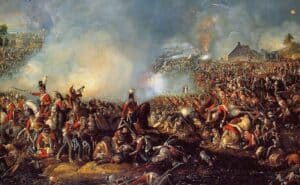
The Battle of Waterloo took place in Belgium on June 18, 1815, and marked the defeat of Napoleon Bonaparte. During the French Revolution, Napoleon rose through the ranks of the French army, seized control of the French government in 1799, and became Emperor in 1804. The Battle of Waterloo, in which Napoleon’s forces were defeated by the British and Prussians, marked the end of his reign and of France’s domination in Europe.
Napoleon's Rise to Power
-
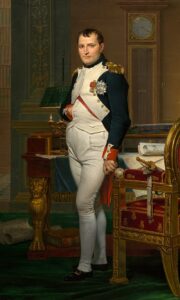
Napoleon Bonaparte Napoleon Bonaparte, who was born in 1769 on the Mediterranean island of Corsica, rose quickly through the ranks of the French military and established himself as a brilliant and daring leader. He was awarded the title of first consul and became France's senior political figure after taking political power in a coup d'état in 1799.
- In 1804, he crowned himself the emperor of France in a grand ceremony. Napoleon led France to victory in a series of wars against different European alliances, and the French empire grew to encompass most of western and central Europe.
- The powers at the Congress of Vienna declared Napoleon an outlaw on March 13, 1815, six days before he arrived in Paris.
- The United Kingdom, Russia, Austria, and Prussia mobilised forces four days later to destroy Napoleon.
- Napoleon, who was severely outnumbered, realised that if his attempts to persuade one or more members of the Seventh Coalition not to invade France failed, his only hope of remaining in power was to strike before the coalition mobilised.
Battlefield and Course of the Battle
- The position at Waterloo was a strong one. It was made up of a long ridge that ran east–west and was bisected by the major route to Brussels. The Ohain road, a deep sunken path, stretched along the ridge's top. A huge elm tree near the crossroads with the Brussels road was roughly in the centre of Wellington's position and served as his command post for the majority of the day. Wellington's men formed a line slightly behind the ridge's crest, following the Ohain road.
- There were three fortification sites in front of the ridge. Hougoumont's château, garden, and orchard were on the far right. This was a huge, well-built country house that had been concealed in the trees for a long time. The residence faced north and had access to a sunken, covered road where it could be supplied. The hamlet of Papelotte was on the far left.
- On June 18, Napoleon led his 72,000-strong army against the 68,000-strong British army, which had taken up position south of Brussels near Waterloo.
- The considerable settlement of Plancenoit was in the right rear of the French position, while the Bois de Paris wood was to the extreme right. Early in the afternoon, Napoleon went to a position near La Belle Alliance, where he could observe the whole battlefield. Michel Ney was given command of the battlefield.
-
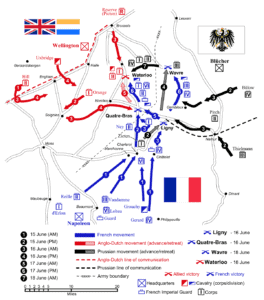
Map of the Waterloo campaign The British army, which included Belgian, Dutch, and German forces, was led by Arthur Wellesley, Duke of Wellington, who rose to fame during the Peninsular War fighting against the French.
- The Namur road crossed the Brussels road to the north of the first crest. Behind the first crest, the major British, German, Belgian, and Dutch positions were along the Namur road. From the land to the south of La Belle Alliance and across the valley, the French approached the fight. Hougoumont Farm, the key to Wellington's right flank, stood in the valley to the front of the Allied line's right-wing. During the engagement, the light companies of the British Coldstream and Third Guards would be battling all day near Hougoumont.
- The capture of La Haye Sante, which was located along the road leading to the heart of Wellington's position, was a critical objective for the French army. Papelotte, another farm to the east of the Duke's troops, would be the scene of furious combat, especially as the Prussian Army arrived on the battlefield towards the conclusion of the conflict. The farm of Mont St Jean, which served as a headquarters and hospital, was located in the Duke's centre.
- Napoleon made a significant miscalculation by delaying the attack until midday to allow the saturated terrain to dry following the previous night's thunderstorm. The delay allowed Blucher's remaining men, estimated to number in the tens of thousands, to march to Waterloo and join the combat later that day.
- The battle began at 11 a.m. on June 18, 1815, when the French bombarded Hougoumont Farm, which was on the extreme right of the Allied line. The French forces massed on the other side of the valley were cannonaded by the British artillery on the ridge behind the farm.
- Prince Jerome ordered the attack on Hougoumont around midday, and his division's French infantry columns advanced to begin the day-long combat around the farm buildings.
- Despite Napoleon's best efforts against the British, the entrance of the Prussians turned the tide against the French. The outmanned army of the French ruler withdrew in chaos.
- According to some estimates, the French suffered more than 33,000 casualties (dead, wounded, or taken prisoner), compared to more than 22,000 for the British and Prussians.
- During the Belgian campaign, Napoleon was said to be tired and ill, and he made tactical blunders and acted indecisively. He was also criticised for picking inept commanders.
Fall of Napoleon
- Napoleon's magnificent military career came to an end at the Battle of Waterloo. He was said to have wept as he rode away from the battle. Wellington went on to become Prime Minister of the United Kingdom, whereas Blucher, who was in his 70s at the time of the Battle of Waterloo, died a few years later.
- Napoleon, who was in his mid-40s at the time, was compelled to abdicate the crown on April 6, 1814. He was exiled to Elba, a Mediterranean island off the coast of Italy, as a result of the Treaty of Fontainebleau.
- Napoleon left Elba and sailed to the French mainland with a company of over 1,000 followers less than a year later, on February 26, 1815. He returned to Paris on March 20, when he was greeted by adoring throngs.
- Napoleon abdicated for the second time on June 22, 1815. He was banished to the isolated, British-controlled island of Saint Helena in the South Atlantic Ocean in October of that year. On May 5, 1821, at the age of 51, he died there, most likely of stomach cancer.
- Napoleon was buried on the island. His bones, however, were restored to France in 1840 and entombed in a vault at Les Invalides in Paris with other French military commanders.

